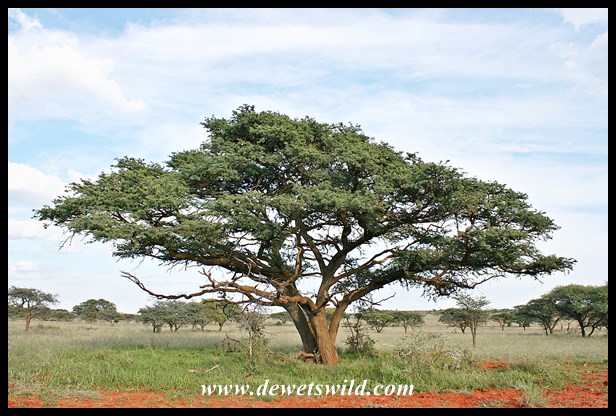Vachellia (Acacia) erioloba
The Camel Thorn is an iconic tree of many arid Southern African landscapes. These trees grow in deep, dry, sandy soils in South Africa (Northern Cape, North West, Free State, Gauteng, Limpopo), Namibia, Botswana, Zimbabwe and parts of Angola and Zambia.
Camel Thorns can grow to 18 meters high, with a widely spreading crown and a tap root that can grow up to 60m deep in order to reach underground water (young trees grow very slowly above ground until their roots reach a reliable supply of ground water). The thorns are paired, often swollen and up to 6cm long. Flowers (clumps of small, yellow balls) are borne from late winter through summer. Camel Thorns are estimated to live to around 250-300 years old.
The wood of Camel Thorns is highly regarded both for lumber and as firewood but as it is a slow-growing species it has been declared a protected species in South Africa in order to prevent it being exploited to extinction. The seeds can be roasted and make a reasonable substitute for coffee. Various parts of the tree is used in traditional medicine to treat ailments ranging from head, ear- and toothache to tuberculosis and gonorrhea, even rabies in dogs. The English name of this tree derives from its Afrikaans name, Kameeldoring, in reference to the leaves and seedpods being a favoured food source for the giraffe (kameelperd), as it is for many other herbivores, both wild and domesticated. Humans also prepare the pods as a porridge.
















So eie aan daardie droë dele…pragtige foto’s en uitstekende artikel oor hierdie besondere boom, dankie Dries
LikeLiked by 1 person
Die Kameeldorings inspireer mens sommer om te begin teken!
LikeLiked by 1 person
Imposing tree with serious thorns! 🙂
janet
LikeLiked by 1 person
And yet even that’s not enough to deter a hungry giraffe!
LikeLiked by 1 person
This looks exactly like the tree in the opening of every National Geographic film. With so many uses, it literally is a “tree of life”! Great pictures too 🙂
LikeLiked by 1 person
Thanks, Jess!
Yes, they’re certainly one of our most iconic plant species and so evocative of our wild places!
LikeLiked by 1 person
It is a very beautiful tree that you associate with South Africa.😊 Reminds a bit about a large bonsai tree.
LikeLiked by 1 person
That’s an intriguing thought, John. I wonder if and where I can get hold of a Camel Thorn bonsai…
LikeLiked by 1 person
That’s a pretty rugged tree with that deep tap root and those formidable thorns, but it also has a very pleasing shape to it.
LikeLiked by 1 person
They just beg to be painted!
LikeLiked by 1 person
how interesting, yes is there caffeine in the pods? Are those spikes or thorns as sharp as they appear?
LikeLiked by 1 person
These thorns can do serious damage to a car’s tyres, Julie! But I don’t think Camel Thorn “coffee” contains caffeine.
LikeLiked by 1 person
it is a beautifully shaped tree.
LikeLiked by 1 person
Absolutely, Lois! And so iconic of our drier landscapes.
LikeLike
Admirable tree! Roots going 60 m deep, that’s really impressive. I wonder how the coffee made from their seeds taste. Does it contain caffeine?
LikeLiked by 1 person
I’ve never tasted it, Hien, but I am curious about the taste as well! None of my references indicate that the “coffee” made from the Camel Thorn tree contains caffeine though.
LikeLiked by 1 person